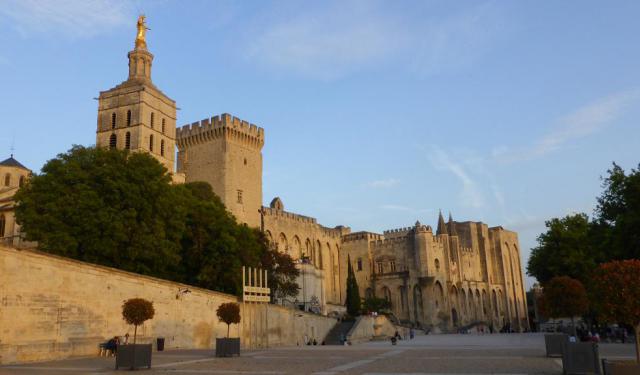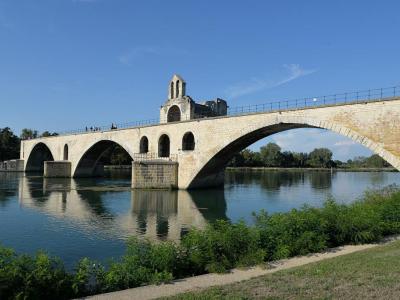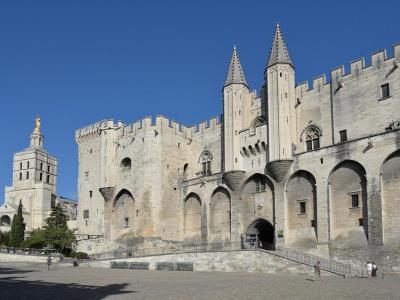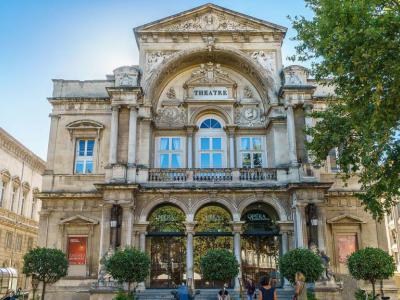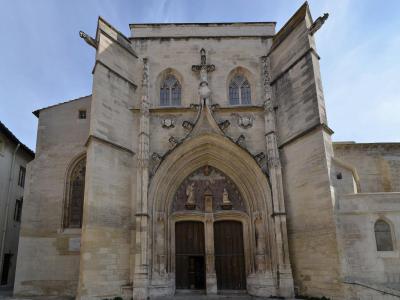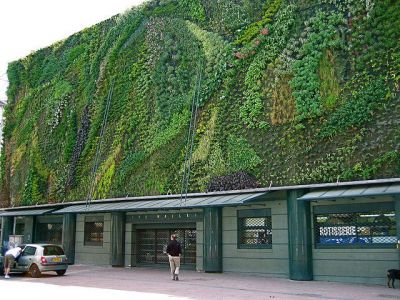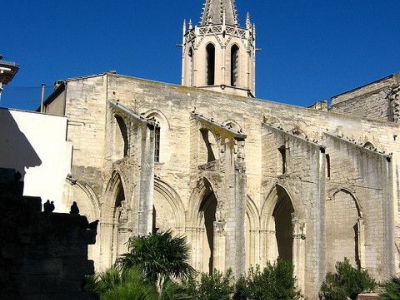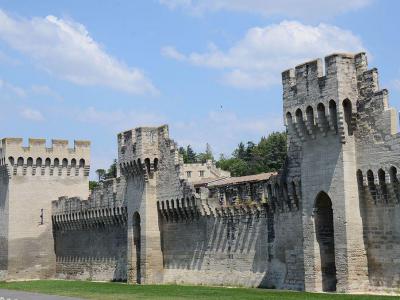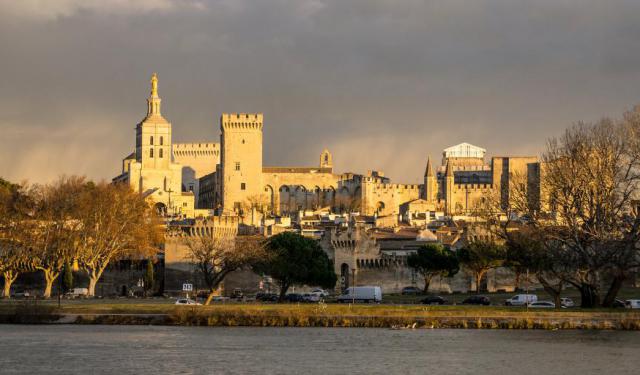Avignon's Architectural Jewels (Self Guided), Avignon
Centuries of history in Avignon are well seen in the stones of some of France’s best preserved architectural monuments. The city's architecture may well not be as diverse as elsewhere in the country, but it is really difficult to find another place whose history is just as complicated and dynamic as Avignon's.
Being one of only two cities on earth that can claim to be the headquarters of the Catholic Church, apart from Rome, Avignon has long placed itself on record as the City of the Popes. Resulting from such an exceptional historic episode as the move of the Holy See from Rome for almost a century was Avignon's major role in the development and diffusion of a particular form of culture throughout a vast region of Europe.
Indeed, the 70-year span of the Avignon Papacy created incredible buildings unlike any other on the continent, making the city a truly unique place – a medieval center of arts, learning, and architecture. Despite its relatively small size, Avignon has no shortage of outstanding sights, such as:
Pont Saint-Bénézet – aka the Avignon Bridge, or rather what's left of the stone overpass that once bridged the Rhône, from 1234 to 1633, until collapsing when the river ran too high; listed as a Historical Monument since 1840.
Palais des Papes – The Palace of the Popes, an austere-looking fortress and outstanding piece of Gothic architecture dominating the city.
Opéra Théâtre – the most gracious of the buildings erected in Avignon in the 19th century.
Eglise Saint-Agricol – the Church of St Agricola, the oldest place of worship in Avignon still in place; built in the early 1300s.
To explore these and other architectural jewels of historic Avignon, take this self-guided walking tour and enjoy yourself.
Being one of only two cities on earth that can claim to be the headquarters of the Catholic Church, apart from Rome, Avignon has long placed itself on record as the City of the Popes. Resulting from such an exceptional historic episode as the move of the Holy See from Rome for almost a century was Avignon's major role in the development and diffusion of a particular form of culture throughout a vast region of Europe.
Indeed, the 70-year span of the Avignon Papacy created incredible buildings unlike any other on the continent, making the city a truly unique place – a medieval center of arts, learning, and architecture. Despite its relatively small size, Avignon has no shortage of outstanding sights, such as:
Pont Saint-Bénézet – aka the Avignon Bridge, or rather what's left of the stone overpass that once bridged the Rhône, from 1234 to 1633, until collapsing when the river ran too high; listed as a Historical Monument since 1840.
Palais des Papes – The Palace of the Popes, an austere-looking fortress and outstanding piece of Gothic architecture dominating the city.
Opéra Théâtre – the most gracious of the buildings erected in Avignon in the 19th century.
Eglise Saint-Agricol – the Church of St Agricola, the oldest place of worship in Avignon still in place; built in the early 1300s.
To explore these and other architectural jewels of historic Avignon, take this self-guided walking tour and enjoy yourself.
How it works: Download the app "GPSmyCity: Walks in 1K+ Cities" from Apple App Store or Google Play Store to your mobile phone or tablet. The app turns your mobile device into a personal tour guide and its built-in GPS navigation functions guide you from one tour stop to next. The app works offline, so no data plan is needed when traveling abroad.
Avignon's Architectural Jewels Map
Guide Name: Avignon's Architectural Jewels
Guide Location: France » Avignon (See other walking tours in Avignon)
Guide Type: Self-guided Walking Tour (Sightseeing)
# of Attractions: 7
Tour Duration: 1 Hour(s)
Travel Distance: 2.4 Km or 1.5 Miles
Author: irenes
Sight(s) Featured in This Guide:
Guide Location: France » Avignon (See other walking tours in Avignon)
Guide Type: Self-guided Walking Tour (Sightseeing)
# of Attractions: 7
Tour Duration: 1 Hour(s)
Travel Distance: 2.4 Km or 1.5 Miles
Author: irenes
Sight(s) Featured in This Guide:
- Pont Saint-Bénézet (St. Benezet Bridge)
- Palais des Papes (Palace of the Popes)
- Opéra Théâtre (Opera Theatre)
- Eglise Saint-Agricol (Church of St. Agricola)
- Les Halles d'Avignon (Avignon Market Halls)
- Eglise Saint Didier (St. Didier Church)
- Remparts d'Avignon (Walls of Avignon)
1) Pont Saint-Bénézet (St. Benezet Bridge) (must see)
The song goes... "On the bridge of Avignon
Everyone is dancing
On the bridge of Avignon
Everyone dances in a ring"
But, actually they danced below the bridge, not on it. Over the years, they worked their way up, the handsome men, the lovely women, the soldiers, the babies, the good friends, the musicians...so the song says, around and around. What does it mean?
The song and the bridge are wrapped in mystery. The bridge referred to in the song, Le Pont d'Avignon is actually Pont Saint Benezet. Saint Benezet (1165-1184) was an illiterate shepherd who became the patron saint of bridge builders, and this is how he did it.
In 1177 he told the bishop he had had a vision wherein he was told to build a stone bridge across the Rhone. The bridge was to be at a point where the force of the river was greatest. The bishop, not wanting to defy Heaven, approved the project and work began. Benezet's holy mission was confirmed by no less than 18 miracles of healing.
The stone bridge that replaced Benezet's damaged bridge in 1234 had 22 arches and 21 piers and was 980 yards long. The arches were low and were liable to collapse when the river ran too high. Only one chapel, Saint Nicholas Chapel, and four arches remain of the bridge. The bridge was listed as a Historical Monument in 1840.
Everyone is dancing
On the bridge of Avignon
Everyone dances in a ring"
But, actually they danced below the bridge, not on it. Over the years, they worked their way up, the handsome men, the lovely women, the soldiers, the babies, the good friends, the musicians...so the song says, around and around. What does it mean?
The song and the bridge are wrapped in mystery. The bridge referred to in the song, Le Pont d'Avignon is actually Pont Saint Benezet. Saint Benezet (1165-1184) was an illiterate shepherd who became the patron saint of bridge builders, and this is how he did it.
In 1177 he told the bishop he had had a vision wherein he was told to build a stone bridge across the Rhone. The bridge was to be at a point where the force of the river was greatest. The bishop, not wanting to defy Heaven, approved the project and work began. Benezet's holy mission was confirmed by no less than 18 miracles of healing.
The stone bridge that replaced Benezet's damaged bridge in 1234 had 22 arches and 21 piers and was 980 yards long. The arches were low and were liable to collapse when the river ran too high. Only one chapel, Saint Nicholas Chapel, and four arches remain of the bridge. The bridge was listed as a Historical Monument in 1840.
2) Palais des Papes (Palace of the Popes) (must see)
The Palace of the Popes has got to be one of the largest, if not the largest, medieval Gothic structures in Europe. It served well as a fortress, palace, and papal residence throughout the 14th century, during the Catholic schism and the "Babylonian Captivity" of the Papacy. Six papal conclaves and seven Popes were maintained in the palace.
The palace is actually two buildings joined together. There is the old palace of Benedict II, firmly ensconced on the rock of the Doms, and the new palace of Clement VI. Clement was known to be the biggest spendthrift of the Popes of Avignon. The palace is probably the best example of International Gothic style.
The designs were made by Pierre Person and Jean de Louvres, two of France's best architects of the time. The ornamentation is beyond lavish and produced by two students from the Siena School, Simone Martini and Matteo Giovanetti. The papal library housed in the palace held over 2,000 volumes. It was a big draw for scholars and humanists.
The palace was huge enough to affect the organization of the church of the time. Services were centralized and the size of the administrative staff exploded. The number of people employed including lay people exceeded 1500 by 1316. In spite of this, the Avignon papacy and administration became irrelevant when operations returned to Rome.
Today the palace is a historical and architectural landmark. It has over 650,000 visitors a year, making it one of the top ten such attractions in France. It houses a convention center and a research center and serves as a library for the archives of the department of Vaucluse.
The place has over 160,000 square feet of floor space. It has twelve strong crenelated towers and walls and arches designed to withstand heavy siege bombardment. The study of Clement VI has celebrated frescoes showing deer hunting scenes. It is popularly known as the "Deer Room." Clement was not known for hunting.
The Palace regularly hosts art exhibitions. The works of Matisse, Braque, Picasso, and Mondrian have been shown there and also single exhibitions of Miguel Barcelo and Stefan Szczesny.
Why You Should Visit:
If you miss the palace you miss the heart and history of Avignon.
The palace is actually two buildings joined together. There is the old palace of Benedict II, firmly ensconced on the rock of the Doms, and the new palace of Clement VI. Clement was known to be the biggest spendthrift of the Popes of Avignon. The palace is probably the best example of International Gothic style.
The designs were made by Pierre Person and Jean de Louvres, two of France's best architects of the time. The ornamentation is beyond lavish and produced by two students from the Siena School, Simone Martini and Matteo Giovanetti. The papal library housed in the palace held over 2,000 volumes. It was a big draw for scholars and humanists.
The palace was huge enough to affect the organization of the church of the time. Services were centralized and the size of the administrative staff exploded. The number of people employed including lay people exceeded 1500 by 1316. In spite of this, the Avignon papacy and administration became irrelevant when operations returned to Rome.
Today the palace is a historical and architectural landmark. It has over 650,000 visitors a year, making it one of the top ten such attractions in France. It houses a convention center and a research center and serves as a library for the archives of the department of Vaucluse.
The place has over 160,000 square feet of floor space. It has twelve strong crenelated towers and walls and arches designed to withstand heavy siege bombardment. The study of Clement VI has celebrated frescoes showing deer hunting scenes. It is popularly known as the "Deer Room." Clement was not known for hunting.
The Palace regularly hosts art exhibitions. The works of Matisse, Braque, Picasso, and Mondrian have been shown there and also single exhibitions of Miguel Barcelo and Stefan Szczesny.
Why You Should Visit:
If you miss the palace you miss the heart and history of Avignon.
3) Opéra Théâtre (Opera Theatre)
The Opéra Théâtre of Avignon is one of the city’s top attractions. The venue has been in operation for almost two centuries, since 1847, replacing the original Greco-Roman-style opera house, built on the site in 1824–1825, and destroyed by fire on 26 January 1846.
The current theatre was constructed from 1846 to 1847, designed by two architects from the neighboring town of Nimes, Léon Feuchère and Théodore Charpentier. Upon completion, the new building was praised as the most gracious of the buildings erected in Avignon in the 19th century, and its façade as of a very sure and elegant taste, with the sculptural decoration free from heaviness or triviality.
Initially, the façade carried two statues, of Molière and Pierre Corneille, created by Jean-Louis Brian and his older brother Joseph. Unfortunately, the material chosen for those statues turned out to be not quite weather proof, and so they had to be retired to the Town Hall whilst being replaced with identical copies. The medallions on the façade feature bas-relief busts of King René and Petrarch made by the sculptor Jean-Baptiste-Jules Klagmann.
In 2020, the Avignon Opéra House underwent renovation.
The current theatre was constructed from 1846 to 1847, designed by two architects from the neighboring town of Nimes, Léon Feuchère and Théodore Charpentier. Upon completion, the new building was praised as the most gracious of the buildings erected in Avignon in the 19th century, and its façade as of a very sure and elegant taste, with the sculptural decoration free from heaviness or triviality.
Initially, the façade carried two statues, of Molière and Pierre Corneille, created by Jean-Louis Brian and his older brother Joseph. Unfortunately, the material chosen for those statues turned out to be not quite weather proof, and so they had to be retired to the Town Hall whilst being replaced with identical copies. The medallions on the façade feature bas-relief busts of King René and Petrarch made by the sculptor Jean-Baptiste-Jules Klagmann.
In 2020, the Avignon Opéra House underwent renovation.
4) Eglise Saint-Agricol (Church of St. Agricola)
The Collegiate Church of Saint Agricola in Avignon stands as one of the city's oldest places of worship, second only to Notre Dame des Doms. Situated in the Fustiers quarter, this historic church was built in the early 1300s on the site of an older temple dating back to between 660 and 700. This original temple was founded by Saint Agricola, a seventh-century bishop known as the protector of crops, who is also one of the patron saints of Avignon. His relics are preserved in the church, which holds a special place in the hearts of the Avignonnais.
The abbey of Saint Agricola is mentioned in documents from the late 11th century, but the current three-story Gothic structure was erected in 1321. A year later, in 1322, Pope John XXII elevated it to a collegiate church and established a chapter of canons. Notably, it is the only 14th-century church in Avignon with side aisles, and over time, it underwent significant modifications. The late 15th century saw the rebuilding of the vaults in 1485, followed by expansions of the bay and nave, and the addition of statues by Ferrier Bernard to the façade. The construction of the bell tower began in 1537, but it was only completed in 1746 with the addition of two more floors.
Following the French Revolution, the church regained its status in 1802 when it was consecrated as a cathedral by the bishop, pending the restoration of the Notre Dame des Doms Cathedral. Today, the church’s Gothic style has been preserved, and it has been listed as a historic monument since 1980. A restoration in 2012 revitalized the building, allowing visitors to appreciate its ancient tombs, epitaphs, inscriptions, and notable paintings by artists such as Simon de Châlons, Grève, and Nicolas Mignard.
The abbey of Saint Agricola is mentioned in documents from the late 11th century, but the current three-story Gothic structure was erected in 1321. A year later, in 1322, Pope John XXII elevated it to a collegiate church and established a chapter of canons. Notably, it is the only 14th-century church in Avignon with side aisles, and over time, it underwent significant modifications. The late 15th century saw the rebuilding of the vaults in 1485, followed by expansions of the bay and nave, and the addition of statues by Ferrier Bernard to the façade. The construction of the bell tower began in 1537, but it was only completed in 1746 with the addition of two more floors.
Following the French Revolution, the church regained its status in 1802 when it was consecrated as a cathedral by the bishop, pending the restoration of the Notre Dame des Doms Cathedral. Today, the church’s Gothic style has been preserved, and it has been listed as a historic monument since 1980. A restoration in 2012 revitalized the building, allowing visitors to appreciate its ancient tombs, epitaphs, inscriptions, and notable paintings by artists such as Simon de Châlons, Grève, and Nicolas Mignard.
5) Les Halles d'Avignon (Avignon Market Halls) (must see)
Avignon Market Halls (Les Halles d'Avignon) located on Pie Square (Place Pie) in the heart of Avignon, is a vibrant marketplace that has become synonymous with the city's gastronomic culture. This covered market, also known as Central Halls (Halles Centrales), hosts around fifty traders offering a diverse range of high quality products including bread, cheese, fruits, vegetables, poultry, pastries, delicatessen items, shellfish, flowers, and both organic and exotic goods. Renowned authors like Peter Mayle and Jean Viard have celebrated the market, solidifying its reputation as a culinary hotspot.
A unique feature of Market Halls is the impressive 600 square meters green wall on the north façade, designed by botanist Patrick Blanc, which adds to the market's distinct allure and serves as a significant city attraction.
The origins of Market Halls trace back to the 16th century when the land, once owned by a man executed as a heretic, was designated for a covered market. Though construction was slow, the market hall was eventually completed in 1624, featuring not just shops but also a guardhouse and a chapel. Over the centuries, the market evolved, with major redevelopment projects taking place in the 19th and 20th centuries. Notably, the first iron market hall was installed in 1864, and a major construction project commenced in 1898, resulting in the current halls being inaugurated in 1899.
Throughout its history, Market Halls has undergone numerous changes, including a roof redesign in the 1920s and various structural modernizations in the mid-20th century, adapting to the shifting commercial landscape with the advent of supermarkets and the subsequent need for downtown revitalization.
Today, Avignon Market Halls is not just a market but a lively community hub where, every Saturday since 2006, chefs and artisans from Greater Avignon engage with visitors through live cooking demonstrations using fresh ingredients from the market. This tradition not only highlights the rich culinary heritage of Avignon but also offers a hands-on experience for food enthusiasts looking to learn and share in the artistry of local cuisine.
A unique feature of Market Halls is the impressive 600 square meters green wall on the north façade, designed by botanist Patrick Blanc, which adds to the market's distinct allure and serves as a significant city attraction.
The origins of Market Halls trace back to the 16th century when the land, once owned by a man executed as a heretic, was designated for a covered market. Though construction was slow, the market hall was eventually completed in 1624, featuring not just shops but also a guardhouse and a chapel. Over the centuries, the market evolved, with major redevelopment projects taking place in the 19th and 20th centuries. Notably, the first iron market hall was installed in 1864, and a major construction project commenced in 1898, resulting in the current halls being inaugurated in 1899.
Throughout its history, Market Halls has undergone numerous changes, including a roof redesign in the 1920s and various structural modernizations in the mid-20th century, adapting to the shifting commercial landscape with the advent of supermarkets and the subsequent need for downtown revitalization.
Today, Avignon Market Halls is not just a market but a lively community hub where, every Saturday since 2006, chefs and artisans from Greater Avignon engage with visitors through live cooking demonstrations using fresh ingredients from the market. This tradition not only highlights the rich culinary heritage of Avignon but also offers a hands-on experience for food enthusiasts looking to learn and share in the artistry of local cuisine.
6) Eglise Saint Didier (St. Didier Church)
The Saint Didier Church in Avignon is a remarkable example of Gothic architecture from the mid-14th century. Designated as a historic monument on July 27, 1983, this former collegiate church is situated in the heart of the city, on the site of an earlier church traditionally believed to have been founded in the 7th century by Agricol d'Avignon. The earliest recorded mention of the church dates back to 1008, in a document where Bishop Rostaing of Avignon donated Saint-Didier and its surrounding land to the Abbey of Montmajour.
The construction of the church was influenced by the Avignon papacy and initiated by Cardinal Bertrand de Deaux, whose will directed the building of a church on his estate. Led by master mason Jaume Alasaud, known for his work on the Palace of the Popes (Palais des Papes), the church was completed in just over three years and consecrated on September 20, 1359. Saint Didier stands today as a prime example of Avignon Gothic architecture.
The church houses significant artworks, including two paintings by Simon de Châlons: "The Flagellation" and "The Descent of the Holy Spirit." It also features a Renaissance bas-relief, "The Carrying of the Cross," commissioned in 1478 by King René and crafted by Francesco Laurana. Originally intended for the high altar of the Church of the Celestines in Avignon, this work now adorns the first right chapel of Saint Didier and is considered one of the earliest examples of Renaissance art in France.
The construction of the church was influenced by the Avignon papacy and initiated by Cardinal Bertrand de Deaux, whose will directed the building of a church on his estate. Led by master mason Jaume Alasaud, known for his work on the Palace of the Popes (Palais des Papes), the church was completed in just over three years and consecrated on September 20, 1359. Saint Didier stands today as a prime example of Avignon Gothic architecture.
The church houses significant artworks, including two paintings by Simon de Châlons: "The Flagellation" and "The Descent of the Holy Spirit." It also features a Renaissance bas-relief, "The Carrying of the Cross," commissioned in 1478 by King René and crafted by Francesco Laurana. Originally intended for the high altar of the Church of the Celestines in Avignon, this work now adorns the first right chapel of Saint Didier and is considered one of the earliest examples of Renaissance art in France.
7) Remparts d'Avignon (Walls of Avignon)
The Walls of Avignon (Les Remparts d'Avignon) are a remarkable series of defensive stone walls encircling the historic city of Avignon in southern France. These fortifications were originally constructed in the 14th century during the Avignon papacy and have undergone various reconstructions and repairs over the centuries, preserving their legacy as a symbol of the city's medieval strength and resilience.
Before the current walls, Avignon was protected by a double set of defensive walls completed in the early 13th century. However, during the Albigensian Crusade, Avignon aligned with Raymond VII, Count of Toulouse, which led to a three-month siege by King Louis VIII of France in 1226. Following its capitulation, the city was compelled to dismantle its fortifications and fill in the moats. Reconstruction efforts began around 1231, though these earlier walls have not survived; their original layout, however, is still reflected in the city’s street plan.
The turning point for Avignon's fortifications came in 1309 when Pope Clement V relocated the papal seat to the city. Under the papacy, Avignon expanded beyond its initial boundaries, and by the 1350s, during the tumultuous period of the Hundred Years' War, the need for enhanced defenses became evident as marauding mercenary bands threatened the town. In 1357, under the direction of Pope Innocent VI, the construction of a new set of city walls commenced to enclose the enlarged city area. This monumental project spanned nearly 20 years.
Today, the walls of Avignon extend for 4.3 kilometers (2.7 miles) and enclose an area of 150 hectares (370 acres). Originally, twelve gates regulated access to the city, but this number was reduced to seven during modifications between 1481 and 1487. Presently, the walls feature 15 vehicular entrances and 11 pedestrian entrances, reflecting the evolving needs of modern urban movement while maintaining their historical grandeur. The Walls of Avignon stand as a testament to the city's rich past, offering a tangible connection to its medieval origins and papal heritage.
Before the current walls, Avignon was protected by a double set of defensive walls completed in the early 13th century. However, during the Albigensian Crusade, Avignon aligned with Raymond VII, Count of Toulouse, which led to a three-month siege by King Louis VIII of France in 1226. Following its capitulation, the city was compelled to dismantle its fortifications and fill in the moats. Reconstruction efforts began around 1231, though these earlier walls have not survived; their original layout, however, is still reflected in the city’s street plan.
The turning point for Avignon's fortifications came in 1309 when Pope Clement V relocated the papal seat to the city. Under the papacy, Avignon expanded beyond its initial boundaries, and by the 1350s, during the tumultuous period of the Hundred Years' War, the need for enhanced defenses became evident as marauding mercenary bands threatened the town. In 1357, under the direction of Pope Innocent VI, the construction of a new set of city walls commenced to enclose the enlarged city area. This monumental project spanned nearly 20 years.
Today, the walls of Avignon extend for 4.3 kilometers (2.7 miles) and enclose an area of 150 hectares (370 acres). Originally, twelve gates regulated access to the city, but this number was reduced to seven during modifications between 1481 and 1487. Presently, the walls feature 15 vehicular entrances and 11 pedestrian entrances, reflecting the evolving needs of modern urban movement while maintaining their historical grandeur. The Walls of Avignon stand as a testament to the city's rich past, offering a tangible connection to its medieval origins and papal heritage.
Walking Tours in Avignon, France
Create Your Own Walk in Avignon
Creating your own self-guided walk in Avignon is easy and fun. Choose the city attractions that you want to see and a walk route map will be created just for you. You can even set your hotel as the start point of the walk.
Avignon Introduction Walking Tour
The thing about a wall around a city is to keep unwanted visitors out. But the massive walls encircling Avignon tend to keep visitors in. And the visitors don't mind it. Is this a mystery? Not when one considers what is inside the walls of Avignon. And forget driving. Park the car and walk.
First encounter is the Popes' Palace. This awesome mountain of a palace was built in the 1300s.... view more
Tour Duration: 2 Hour(s)
Travel Distance: 3.0 Km or 1.9 Miles
First encounter is the Popes' Palace. This awesome mountain of a palace was built in the 1300s.... view more
Tour Duration: 2 Hour(s)
Travel Distance: 3.0 Km or 1.9 Miles
The Most Popular Cities
/ view all
